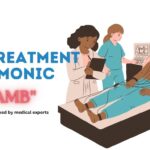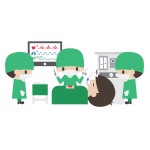In this article, we are going to share with you high-yield PLAB 1 topics which you must study thoroughly before the exam for scoring maximum. This list of important PLAB 1 topics has been devised by a community of online International Medical Graduates (IMGs) who have been closely monitoring PLAB 1 past papers and what they have noticed are recurring patterns and topics which arguably appear to be the “favourites” of the examiners preparing the PLAB 1 exam. So, the PLAB community has prepared a list of high-yield PLAB 1 topics which has been made public so that maximum people could benefit from it. 🙂
We came across this document containing high-yield PLAB 1 topics last night so decided of sharing it here as a blog post and as a PDF file as well. We hope our readers will find this blog post useful!
BEST OF LUCK EVERYONE! 🙂
Here are a few of our most popular articles related to the PLAB licensure exam:
**RECOMMENDED READING**
PLAB or MRCP – Which One is Better?
List of Important Topics For PLAB 1 Exam
PLAB 1 Recall Questions 2014-2017 PDF Free Download
High-Yield PLAB 1 Important Topics
Below are the high-yield PLAB 1 topics divided subject/topic-wise. It is highly recommended that you have a very good command over these topics for excelling in the exam:
HAEMATOLOGY
1. Abnormal blood film
a) Peripheral blood film (red cell, white cell and platelets)
b) Differential white cell count
c) Pancytopenia
d) Bone marrow failure
e) ESR
f) Hyperviscosity syndrome
g) Spleen and splenectomy
2. Haematological malignancies and myeloproliferative disorders
a) Leukaemia
b) Myeloma
c) Paraproteinemia
d) Amyloidosis
3. Bruising/ bleeding/ purpura
a) Intrinsic and extrinsic pathways (clotting)
b) Any cause including
c) Bleeding disorder
d) Anticoagulants
e) Thrombophilia
4. Immunosuppressive drugs
5. Inherited bleeding disorders Anaemia of any cause
a) Iron deficiency anaemia
b) Refractory anaemia
c) Anaemia of chronic disease
d) Sideroblastic anaemia
e) Macrocytic anaemia (all causes)
f) Pernicious anaemia
g) Haemolytic anaemia
h) Sickle cell anaemia
i) Thalassaemia anaemia
j) Transfusion (safety & procedures)
k) (Myeloproliferative disorders)
6. Generalised enlarged lymph nodes: any cause
BREAST LUMP AND/OR PAIN
1. Cancer
2. Infection
a) abscess;
b) puerperal mastitis
3. Benign
a) fibro-adenoma;
b) fibro-adenosis;
c) fat necrosis; cysts)
4. Nipple
a) discharge;
b) inversion;
c) Paget’s
5. Request for reduction/augmentation
CARDIOVASCULAR
1. Chest Pain
a) Acute myocardial infarction, acute coronary syndrome and angina
b) Acute myocardial infarction (MI)
c) Acute coronary syndrome (ACS)
d) Angina pectoris
e) Electrocardiogram (ECG) – normal and abnormal
f) Investigations (cardiac catheterization; echocardiography; nuclear
cardiology; ECG: exercise/ ambulatory)
g) Complications of MI (arrhythmias; hypertension)
h) Atherosclerosis
2. Heart Murmur: any cause
3. Hypertension: all, including risk factor
4. Palpitations
a) Bradycardia
b) Narrow complex tachycardia
c) Atrial fibrillation and flutter
d) Broad complex tachycardia
e) Pacemakers
5. Peripheral arterial disease
a) Aneurysms
b) Ischaemic limb
c) Occlusions
6. Peripheral oedema and Heart failure including valvular heart disorder and
rheumatic heart disease
a) Rheumatic fever
b) Mitral valve disease
c) Aortic valve disease
d) Right heart valve disease
e) Indications for cardiac surgery
f) Infective endocarditis
g) Diseases of heart muscle including myocarditis
h) Pericardial disease
i) Dyspnoea in heart failure
7. Peripheral Venous problems
a) VTE
b) DVT
c) Risk Factors
d) Varicose Veins
DEVELOPMENTAL PROBLEMS
1. Congenital Abnormalities
a) Ventricular septal defect
b) Atrial septal defect
c) Patent ductus arteriosus
d) Aortic stenosis
e) Pulmonary stenosis
f) Coarctation of the aorta
g) Fallot’s tetralogy
h) Transposition of the great arteries
i) Tricuspid atresia
j) Total anomalous pulmonary venous return
k) Persistent truncus arteriosus
l) Hypoplastic left heart
m) Pulmonary atresia
n) Ebstein’s anomaly
o) Polycystic kidneys
p) Congenital adrenal hyperplasia
q) Chromosomal abnormalities (including Turner’s; Down’s; Tay Sachs’)
r) Inherited conditions (cystic fibrosis; PKU)
s) Acquired conditions (including caused by drugs/alcohol)
t) Neural tube defects (including spina bifida)
u) Developmental abnormalities of the musculoskeletal system (including
talipes)
2. Developmental Delay/ Failure to thrive
a) Endocrine problems/ Metabolic disorders
b) Malabsorption (see also under Digestive)
c) Inadequate diet
3. Psychological and Social
a) Non-accidental injury
b) Sexual abuse
c) Emotional deprivation
d) Bullying
e) Manifestations of neglect
DIGESTIVE
1. Abdominal Mass
a) Organomegaly
b) Hernias
c) Ascites
2. Abdominal Pain
a) Perforation
b) Obstruction
c) Ischaemia
d) Aneurysm (see also under Cardiovascular/ Peripheral arterial disease)
e) Inflammatory conditions (including diverticulitis; appendicitis, pancreatitis)
f) Colic: ureteric (see also under Renal), Biliary/ gallbladder (see also under
Jaundice)
3. Anorexia and weight loss
a) Cancer
b) Metabolic causes including diabetes (see under Endocrine/ Abnormal
blood sugar);
c) thyroid (see under Endocrine/ Thyroid abnormalities)
d) Malabsorption
e) Physical causes of anorexia
f) Psychological causes of anorexia (see also under Mental health/ Eating
problems
4. Facial Swelling
a) Cancer
b) Sinusitis
c) Salivary glands
d) Teeth
e) Oral cavity
f) Lymph nodes (see also under Blood and lymph)
5. Jaundice
a) Pre-hepatic (including haemolysis)
b) Hepatic (including drug-induced)
c) Post-hepatic (including biliary obstruction)
6. Lower GI Problems
a) Including faecal incontinence
b) Spurious diarrhoea and encopresis
c) Cancer
d) Ulceration
e) Bleeding
f) Abnormal anatomy (fissures, piles, prolapse)
g) Masses (including polyps)
h) Altered bowel habit (constipation, diarrhoea)
i) Rectal pain
j) Pruritis ani
k) Inflammation (including IBD)
7. Upper GI Problems
a) Including nausea and vomiting
b) Infections (including food poisoning, UTI, gastroenteritis)
c) Pyloric stenosis (see also under Developmental)
d) Drug-induced
e) Raised intracranial pressure
f) Pregnancy (see also under Reproductive)
g) Constipation
h) Cancer
i) Ulceration
j) GERD
k) Bleeding
l) Dysphagia (including tumours; benign; neurological causes; congenital;
acquired)
8. Nutrition
a) Recognises nutritional disorders are common in patients with long-term
conditions
b) Performs basic nutritional screen and recognises patients with potential for
nutritional deficiencies and considers this in planning care
c) Formulates a plan for investigation and management of weight loss or
weight gain
d) Demonstrates the knowledge, skills, attitudes and behaviours to assess
patients’ basic nutritional requirements
e) Recognises major nutritional abnormalities and eating disorders and
establishes a management plan, where relevant with other healthcare
professional input
f) Works with other healthcare professionals in addressing nutritional needs
and communicating these during care planning
g) Makes nutritional care part of daily practice
h) Considers the additional effects of long-term ill-health on nutritional status
and the effect of poor nutrition on long-term health.
ENDOCRINE
1. Diabetes Mellitus
a) Type 1 diabetes
b) Type 2 diabetes
c) Complications (including diabetic retinopathy; neuropathy; arterial disease)
d) Diabetic foot care
e) Hypoglycaemia/ hyperglycaemia
f) Patient with diabetes undergoing surgery
g) Diabetes in pregnancy (see also under Reproductive)
2. General
a) Hyperparathyroidism
b) Hypoparathyroidism
c) Multiple endocrine neoplasia (MEN 1 and MEN 2)
3. Adrenal
a) Adrenal gland
b) Addisonian crisis
c) Addison’s disease
d) Hyperaldosteronism
e) Phaeochromocytoma
f) Virilism
g) Gynaecomastia (see under Breast)
h) Impotence (see under Reproductive/ Fertility problems)
i) Cushing’s syndrome
4. Pituitary gland
a) Hypopituitarism
b) Pituitary tumours
c) Hyperprolactinaemia; hypoprolactinaemia
d) Acromegaly
e) Diabetes insipidus
f) Hypopituitary coma
5. Thyroid Disorders
a) Cancer
b) Hyperthyroidism
c) Thyroid eye disease
d) Hypothyroidism
e) Thyroid disease in pregnancy (see also under Reproductive/ Problems in
pregnancy)
f) Goitre; nodules
g) Thyroid emergency
Ear, Nose and Throat (ENT)
1. Earache any cause
a) Cancer
b) Infection
c) Eustachian tube dysfunction
2. Hearing Problems: any cause
a) Foreign body (including wax)
b) Conductive and nerve deafness
3. Hoarseness and stridor any cause
a) Cancer
b) Infection (including epiglottitis)
c) Voice misuse (including nodules)
d) Nerve injury (including palsies)
e) Stridor (see also under Thyroid abnormalities/ Goitre)
4. Nasal Symptoms
a) Cancer
b) Bleeding
c) Nasal obstruction (including polyps; allergic rhinitis)
d) Infections
e) Trauma (including fractures)
5. Vertigo any cause
a) Ménières disease
b) Labyrinthitis
c) Cancer
d) Cerebellar lesions (see also under Neurological)
e) Benign positional
f) Toxins (including alcohol)
EYE
1. Eye Pain
a) Cancer
b) Sinusitis (see also under ENT)
c) Glaucoma
d) Migraine (see also under Neurological/ Headache
e) Foreign body
2. Orbital Swelling
a) Cancer
b) Infection (including cellulitis; blepharitis)
c) Thyroid disease (see under Endocrine)
d) Cysts: congenital and acquired
e) Eyelid Disorder
3. Red eye
a) Infection
b) Conjunctivitis
c) Iritis
d) Trauma (including foreign body)
e) Scleritis/ episcleritis
f) Glaucoma
g) Subconjunctival haemorrhage
h) Polycythaemia
4. Visual impairment
a) Tumours (including pituitary)
b) Arterial and venous
c) Lens (including cataract; dislocation)
d) Degenerative
e) Hereditary
f) Systemic conditions: including connective tissue; diabetes (see also under
Endocrine)
g) Drug-induced
h) Infections
i) Detached retina
j) Vitreous haemorrhage (including floaters)
GENITOURINARY
1. Urethral Discharge any cause
a) Infection (including STI)
b) Cancer
c) Foreign body
2. Vaginal Discharge any cause
a) Pruritis vulvae
b) Normal physiological
c) Cancer
d) Infection (including STI)
e) Foreign body
f) Child sexual abuse (see also under Developmental problems)
HOMEOSTATIC
1. Acid-base imbalance and blood gas abnormalities
a) Metabolic and respiratory acidosis or alkalosis
b) Kidney function (tubular dysfunction, low GFR, chronic renal failure)
2. Electrolyte abnormalities
a) Sodium,
b) potassium,
c) glucose,
d) calcium
e) SIADH
f) Magnesium
g) Zinc
h) Selenium
i) Water
INFECTIOUS DISEASE
1. Hospital Acquired Infection
a) Infection Control
b) MRSA
c) C. diff
d) Management of Sepsis
- a. Understands the seriousness of sepsis
- b. Understands and applies the principles of managing a patient with
sepsis - c. Involves the infection control team at an appropriate early stage
- d. Takes appropriate microbiological specimens in a timely fashion
- e. Follows local guidelines/protocols for antibiotic prescribing.
2. Serious infection
a) HIV
b) AIDS
c) Hep B
d) And Tb
3. Travel Medicine and Tropical infections: any cause
a) Malaria
b) Bilharzia
c) Dengue fever
d) Lyme disease
e) Toxoplasma
f) Rabies
g) Yellow fever
4. Viral Infections
a) Exanthemata
b) Mumps
c) Measles
d) Rubella
e) Herpes simplex
f) Herpes zoster
g) Viral meningitis
h) Influenza
MENTAL HEALTH
1. Alcohol and drug misuse and dependence
a) Including co-morbidity and withdrawal
b) Substitution therapy
c) Acute intoxication
d) Harmful use
2. Anxiety
a) Including generalised anxiety disorder, phobias and OCD
b) Panic attack
c) Obsessive compulsive disorder
3. Deliberate self-harm
a) Overdose, poisoning and other self-harm
b) Suicidal risk
4. Eating Problems
a) Anorexia
b) Bulimia nervosa
5. Learning and communication problems Any cause
a) Intellectual disability
b) Acquired brain injury
6. Medically-unexplained physical symptoms
a) Including psychosomatic disorders,
b) somatization disorders
7. Mood/ affective problems
a) Depressive disorders
b) Bipolar disorders
c) Suicidal risk
8. Organic Brain Syndrome
a) Delirium
b) Dementia
c) Encephalopathy
9. Personality and behavioural disorders
a) Emotionally unstable personality disorder
b) Antisocial personality disorder
c) Pathological gambling
d) Pyromania
10. Psychosis
a) Schizoaffective disorder
b) Delusional disorders
MUSCULOSKELETAL
1. Back and Neck
2. Connective tissue Disorders
3. Foor and Ankle
4. Hand and Wrist
5. Hip
6. Knee
7. Rheumatological problems
a) Rheumatoid
b) Osteoarthrosis
c) Psoriatic
d) Lupus
e) Polymyalgia rheumatica
f) Gout
8. Upper limb
9. Skeletal
a) Disorders of calcium homeostasis (osteoporosis, osteomalacia, Paget’s)
b) Infections
c) Tumours (benign, malignant, secondaries)
d) Fractures of long bones
10. Fractures
NEUROLOGICAL
1. Blackouts and Faints
a) Loss of consciousness of any cause
b) Vasovagal syncope
c) Cough syncope
d) Effort syncope
e) Micturition syncope
f) Carotid sinus syncope
g) Epilepsy
h) Stokes Adams attacks
i) Hypoglycaemia
j) Orthostatic hypotension
k) Drop attacks
2. Cranial Nerve Problems
a) Any cause including visual field defects
b) Multiple sclerosis (MS)
c) Space occupying lesions
d) Bell’s palsy
3. Falls
a) Complications including subdural, extradural
b) Any cause including environmental
c) Dizziness
d) Vertigo (benign positional vertigo)
e) Ménières disease
f) Ototoxicity
g) Vestibular nerve problems (Acoustic neuroma, vestibular neuronitis,
herpes zoster, brain stem)
4. Headache
a) Any cause including environmental
b) Dizziness
c) Vertigo (benign positional vertigo)
d) Ménières disease
e) Ototoxicity
f) Vestibular nerve problems (Acoustic neuroma, vestibular neuronitis,
herpes zoster, brain stem)
5. Movement Disorder including tremor and gait
a) Abnormalities of the motor nervous system
b) Chorea
c) Athetosis
d) Hemiballismus
e) Tics, myoclonus, dystonia and tardive dyskinesia
f) Parkinson’s disease
g) Parkinsonism
6. Peripheral nerve problem
a) Testing peripheral nerves
b) Dermatomes
c) Including neuropathies of any cause
d) Autonomic neuropathy
e) Mononeuropathy’s
f) Polyneuropathy’s
g) Bulbar palsy
h) MND
i) Cervical spondylosis
j) Neurofibromatosis
k) Syringomyelia
7. Seizure
a) Epilepsy
b) Convulsion
8. Speech and Language
9. Weakness and Fatigue
a) Cerebral artery territories
b) Upper motor neurone vs lower motor neurone
c) Muscle weakness grading
d) Cord compression
e) Transverse myelitis
f) Carcinomatosis
g) Meningitis
h) Guillain-barre
i) Cord infarction
j) Spinal artery thrombosis
k) Trauma
l) Dissecting aortic aneurysm
m) Cauda equina lesions
n) Management of paralysed patient
o) Leg weakness (spastic paraparesis, flaccid paraparesis, unilateral foot
drop, weak legs with no sensory loss, absent knee jerks and extensor
planters)
p) Recognition of different gait disorders
q) Stroke (mimics, risk factors, site of lesion, investigation management and
treatment, rehabilitation, TIA, SAH)
r) Myopathy
s) Myasthenia gravis
RENAL
1. Urine Abnormalities
a) Blood, protein, pH, volumes
b) Renal calculi
c) Renal tract obstruction
d) Retroperitoneal fibrosis
e) Glomerulonephritis
f) Nephrotic syndrome
g) Renal vein thrombosis
2. Renal Problems
a) Urinary tract imaging
b) Renal biopsy
c) Acute renal failure
d) Chronic renal failure, renal replacement therapy, renal transplantation
e) Interstitial nephritis
f) Nephrotoxins
g) Renal vascular disease
h) Renal tubular disease
i) Inherited kidney diseases
j) Renal manifestations of systemic disease
3. Urinary excretion
a) Oliguria and polyuria including renal failure;
b) urate
4. Urinary Symptoms
a) Pyelonephritis
b) Acute and chronic urinary tract infection (UTI)
c) Frequency
d) Incontinence
e) Enuresis
REPRODUCTIVE
1. Contraception
a) Oral contraceptive pill
b) Intrauterine contraceptive devices (IUCDs)
c) Implants
2. Fertility Problems
a) Both male and female;
b) including normal development in puberty
3. Normal Pregnancy and care
a) Including prenatal diagnosis
b) Role of folic acid
c) Risks to fetus including smoking, alcohol, food issues
4. Problems in Pregnancy
a) Including antepartum haemorrhage, postpartum haemorrhage and
miscarriage
b) Ectopic pregnancy
c) Pre-eclampsia, eclampsia and hyperemesis
d) Thyroid disease in pregnancy
e) Epilepsy
f) Anticoagulation
g) Prematurity
h) Low birth weight
5. Irregular vaginal bleeding
a) Including antepartum haemorrhage, postpartum haemorrhage and
miscarriage
b) Ectopic pregnancy
c) Pre-eclampsia, eclampsia and hyperemesis
d) Thyroid disease in pregnancy
e) Epilepsy
f) Anticoagulation
g) Prematurity
h) Low birth weight
6. Pelvic mass
a) Including antepartum haemorrhage, postpartum haemorrhage and
miscarriage
b) Ectopic pregnancy
c) Pre-eclampsia, eclampsia and hyperemesis
d) Thyroid disease in pregnancy
e) Epilepsy
f) AnticoagulationBreath
g) Prematurity
h) Low birth weight
7. Pelvic Pain
a) Endometriosis
b) PID
c) Dyspareunia
8. Vulval and vaginal lump/lesions
RESPIRATORY
1. Breathlessness
a) Pulmonary fibrosis
b) Any infection, inflammation, including COPD, asthma, occupational lung
disease, sleep apnoea and cyanosis
c) Respiratory system examination, age related changes, chest x-ray
d) Pneumonia including CURB 65
e) Chronic obstructive pulmonary disease (COPD), acute respiratory distress
syndrome
f) Respiratory failure
g) Pulmonary embolus
h) Pneumothorax
i) Pleural effusion
j) Extrinsic allergic alveolitis
k) Cryptogenic fibrosing alveolitis
l) Industrial dust diseases
m) Obstructive sleep apnoea
n) Cor pulmonale
2. Chest Pain
a) Including any pleuritic cause
b) Mesothelioma
c) Pneumothorax
3. Cough and Haemoptiasis
a) Cough and haemoptysis
b) Bronchiectasis
c) Cystic fibrosis
d) Fungi
e) Lung cancer
f) Sarcoidosis
4. Wheeze/ Stridor
a) Asthma – acute and chronic
b) Bronchodilators and steroids
SERIOUSLY ILL PATIENT
1. Collapse
a) Subdural, extradural, intracerebral haemorrhage including subarachnoid
haemorrhage (SAH)
b) Hypertensive encephalopathy
c) Epilepsy
d) Addisonian crisis
e) Drug poisoning
f) Hypoglycaemia
g) Hyperglycaemia
h) Hypoxia
i) Hypothermia
j) Encephalopathy
2. Fever/Infection
a) Including pyrexia of unknown origin, septicaemia, meningitis and
neutropenic sepsis
b) Bacterial viral meningitis
c) Pneumonia
d) Acute severe asthma
e) PE
3. Multiple Trauma
a) Including head injury and intra-abdominal injury
4. Shock
a) Paracetamol overdose
b) Salicylate overdose
c) Any cause including blood loss
d) Acute myocardial infarction (MI)
e) Intra abdominal blood loss
f) Massive pulmonary embolus
g) Burns
SKIN
1. Bites and Stings
a) Including infestations
b) Insect
c) Fish
d) Scorpion
e) Snake
f) Dog/cat bites
g) Human bite
h) Scabies
i) Lice
2. Bullous
a) Pemphigus
b) Pemphigoid
3. Dermatological manifestations of systemic disease
a) Endocrine
b) Cancer
c) Connective tissue
4. Extremes of Temperature
a) Burns,
b) frostbite,
c) hyperthermia
d) hypothermia
5. Itchy and scaly rashes
a) Excess hair
b) Hair loss
c) Nail changes in systemic diseases
d) Psoriasis
e) Fungal infections of nails
6. Hair and nail
a) Including eczema,
b) dermatoses (psoriasis etc.)
c) reactions (drugs/food)
7. Infections
a) Including viral,
b) bacterial and
c) fungal infections
8. Lumps
a) Nodular lesions
b) Skin tumour
c) BCC
d) Ganglion
9. Moles and Pigmented lesions
a) Benign
b) Vitiligo
c) Malignant including melanoma
10. Ulcers
a) Arterial
b) Venous
c) Neuropathic
d) Malignant
UROLOGICAL
1. Groin scrotal pain and or swelling
a) Torsion of testis
b) Hernias
c) Hydrocele
d) Tumour
e) Orchitis
f) Infection
2. Urinary tract obstruction
a) Calculus
b) Tumours (benign and malignant)
c) Strictures
d) Bladder neck obstruction
e) Enuresis
** END OF THE ARTICLE **





![1700 by Dr. Khalid Saifullah PLAB 1 MCQs Explanations [PDF Download]](https://www.medicosrepublic.com/wp-content/uploads/2017/09/1700-by-Dr.-Khalid-Saifullah-PLAB-1-MCQs-Explanations-218x150.jpg)
![PLAB 1 Recall Questions 2014-2017 PDF Free Download [Direct Link] PLAB 1 Recall Questions](https://www.medicosrepublic.com/wp-content/uploads/2017/09/PLAB-1-Recall-Questions-2014-2017-PDF-Free-Download-218x150.jpg)

![PTCE – Pharmacy Technician Certification Exam Flashcard 3rd Edition PDF Free Download [Direct Link] PTCE - Pharmacy Technician Certification Exam Flashcard 3rd Edition PDF](https://www.medicosrepublic.com/wp-content/uploads/2023/02/PTCE-Pharmacy-Technician-Certification-Exam-Flashcard-3rd-Edition-PDF-Free-Download-150x150.jpg)
![BECKER USMLE Step 1 Physiology PDF Free Download [Direct Link]](https://www.medicosrepublic.com/wp-content/uploads/2022/06/BECKER-USMLE-Step-1-Physiology-PDF-1-696x365-1-150x150.jpg)
![Brant and Helms’ Fundamentals of Diagnostic Radiology 5th Edition PDF Free Download [Direct Link] Brant and Helms' Fundamentals of Diagnostic Radiology 5th Edition PDF](https://www.medicosrepublic.com/wp-content/uploads/2019/02/Brant-and-Helms-Fundamentals-of-Diagnostic-Radiology-5th-Edition-PDF-Free-Download-150x150.jpg)
![Eureka: Endocrinology PDF Free Download [Direct Link] Eureka: Endocrinology PDF](https://www.medicosrepublic.com/wp-content/uploads/2019/07/Eureka-Endocrinology-PDF-Free-Download-150x150.jpg)

![Reflective Practice in Nursing 5th Edition PDF Free Download [Direct Link] Reflective Practice in Nursing 5th Edition PDF](https://www.medicosrepublic.com/wp-content/uploads/2018/08/Reflective-Practice-in-Nursing-5th-Edition-PDF-Free-Download-150x150.jpg)
![Sulfonamide Major Side Effects Mnemonic [Fun & Easy-to-Remember] Sulfonamide Major Side Effects Mnemonic](https://www.medicosrepublic.com/wp-content/uploads/2023/03/Sulfonamide-Major-Side-Effects-Mnemonic-150x150.jpg)
![Health Insurance 2nd Edition PDF Free Download [Direct Link]](https://www.medicosrepublic.com/wp-content/uploads/2023/02/Health-Insurance-2nd-Edition-PDF-Free-Download-150x150.jpg)
![Infections of the Central Nervous System 4th Edition PDF Free Download [Direct Link] Infections of the Central Nervous System 4th Edition PDF](https://www.medicosrepublic.com/wp-content/uploads/2023/01/Infections-of-the-Central-Nervous-System-4th-Edition-PDF-Free-Download-150x150.jpg)
![Cardiac Mechanobiology in Physiology and Disease PDF Free Download [Direct Link] Cardiac Mechanobiology in Physiology and Disease PDF](https://www.medicosrepublic.com/wp-content/uploads/2023/07/Cardiac-Mechanobiology-in-Physiology-and-Disease-PDF-150x150.jpg)





hi
My name is Chinas a and I have a B s c. biochemistry from a federal university in Nigeria.
I want to register for MOH License and how can I get materials on clinical biochemistry?